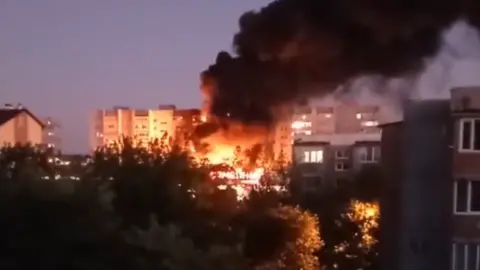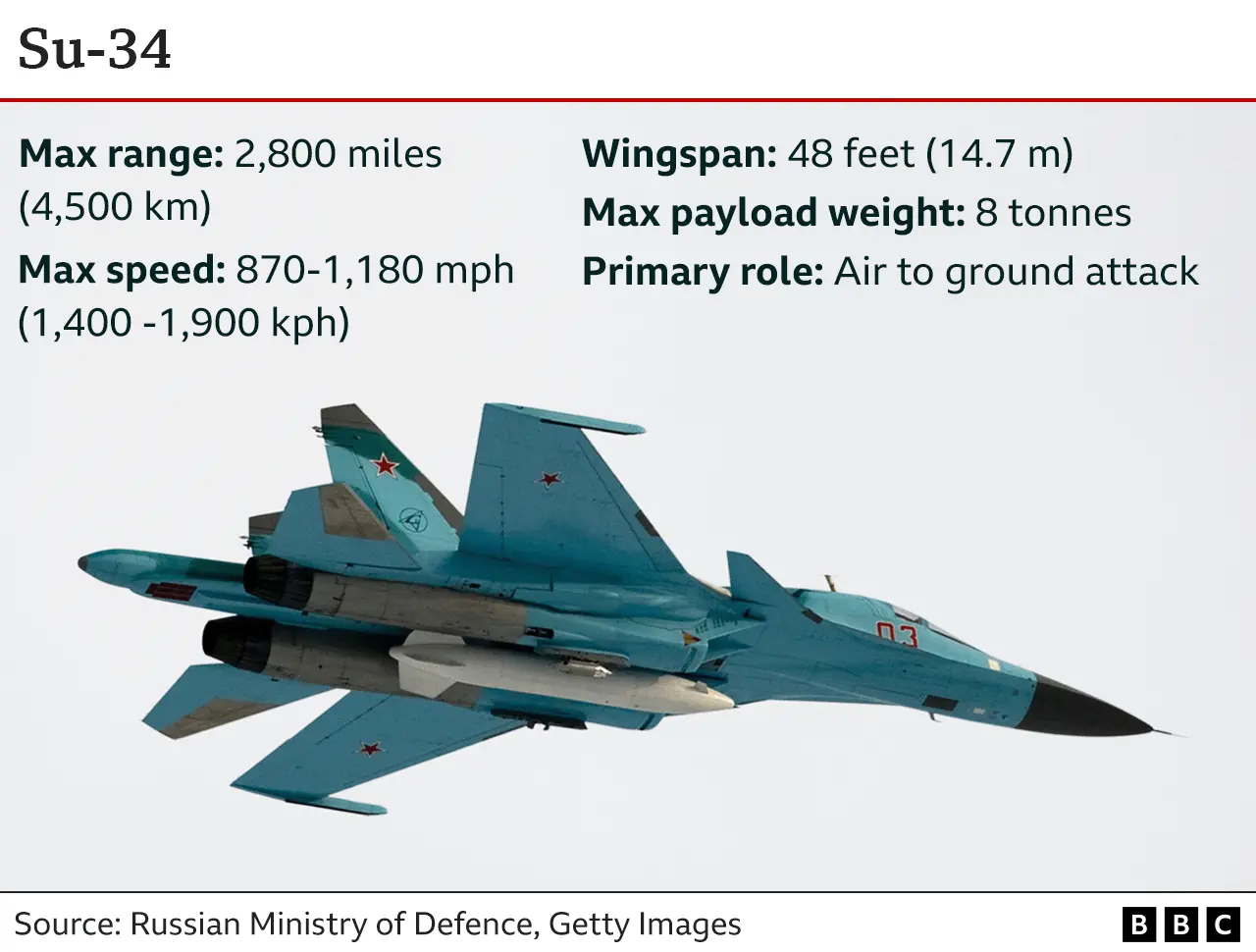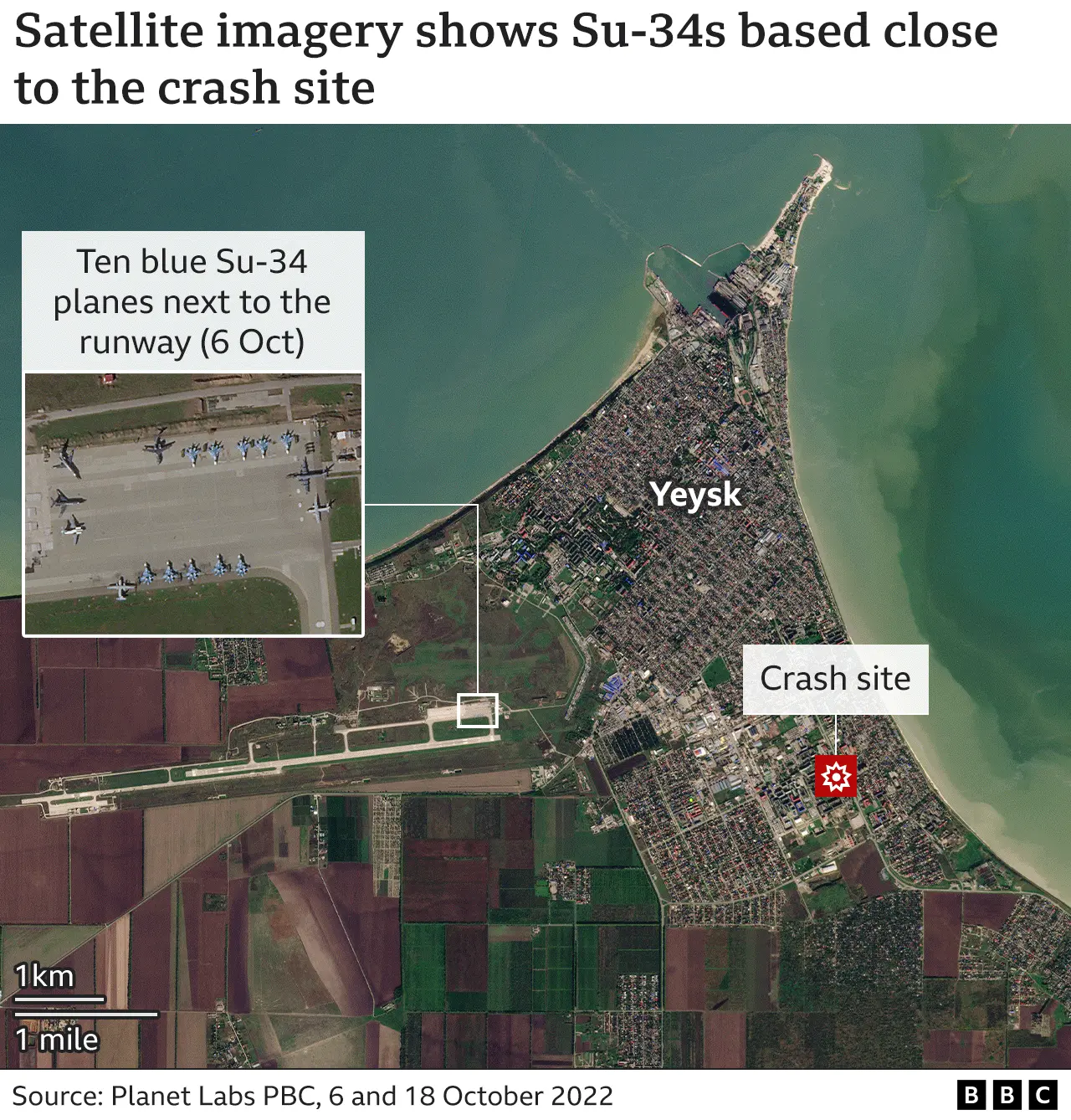How did jet crash into a block of flats in Russia?
 Twitter
TwitterAn investigation is underway into the crash of a fighter jet in the Russian city of Yeysk on Monday in which 15 people were killed, including three children.
Dramatic videos and images have surfaced across social media, allowing us to try to piece together what happened.
What do we know?
On Monday evening, an Su-34 fighter-bomber crashed into a residential building in the Russian city of Yeysk, more than 100 miles (160km) from Ukrainian held territory.
The Russian defence ministry has suggested that a malfunction in one of the engines was the most likely cause.

Videos on social media showed a large fire and smoke billowing out of a high-rise block.
Several of these have been verified by the BBC to confirm the north side of a nine-storey block just off a main road in Yeysk had been hit.
In the videos, the same landmarks and buildings can be seen. We cross referenced these with Google street view images to confirm the crash happened just off the Ulitsa Kommunisticheskaya dual carriageway in the south of Yeysk.
The weather also matched in each video, with clear skies and the sun setting, so we can be confident that the crash happened about 17:30 local time.
The Russian Defence Ministry has said the Su-34 crashed after taking off for a training flight from a military airfield near Yeysk.
In video of the fire after impact, crackling sounds and some bangs can be heard. These could have been caused by ammunition which was being carried by the plane during training exercises igniting.
Russian officials say the fire was caused by a fuel spill and insist that there were no explosions of ammunition.
The Su-34 is a fighter bomber operated by two pilots which is often deployed to hit ground targets.

"Su-34s are one of Russia's more advanced aircraft but it still has problems that have manifested, particularly in training," says J Andrés Gannon, a security expert at the US Council on Foreign Relations (CFR).
There have been two other cases of Su-34s crashing this year that were unrelated to enemy fire, according to Air Forces Monthly, a UK publication that tracks military aircraft data.
How did it happen?
A vehicle passing on a major road near to the block captured the crash on its dashcam. The video was later posted on Telegram and shared on Twitter.
It shows an aircraft descending, then two flashes which experts say appear to be the pilots ejecting, before the plane hit the building.
Towards the end of the video, two parachutes can be seen descending - one of them brightly illuminated by the crash explosion.
The photograph below appeared on Telegram showing a pilot with a parachute on the right.

We've verified the image by comparing the position and angle of the parachute descent with the video of the incident shown above.
The parachute has orange circles around it, identifiable as markings on Russian military kit, and matching an example of a Russian pilot seen ejecting over Syria in 2018.
A video posted on Telegram near the crash site shows a pilot lying on the ground with a parachute to the west of the damaged building.
The pilot is alive, lying on his back, and responding to questions.
A person asks the pilot in Russian "Is all normal?" to which he responds "Yes, yes." When asked whether his plane was shot down, the pilot says "No."
We don't know what happened to the second pilot, but Russia says both of the pilots ejected before impact.
The plane appears to have been flying in from the west, possibly from an airport on the outskirts of the city which has a military airfield.

A satellite image taken earlier this month shows ten planes at the airfield which match the dimensions and colour of Su-34 aircraft.
What do the experts say?
We showed the video evidence from social media to several security and airpower experts to get their assessment of what might have happened.
Andres Gannon, from the CFR said the visual evidence indicated an engine malfunction was the main cause of the crash. This may have caused the fuel supply to ignite, consistent with two flashes of light clearly seen in videos.
"The first is likely when the fuel supply was ignited from the engine failure, and then the second flash makes sense as far as when the hatches where the pilots were sitting ignite for ejection.
"We don't see something that seems like a missile strike. We don't see any heat or light from any source that's coming towards it."
"It's hard to believe it's a missile strike," says Mark Cancian, a defence adviser at the International Security Program.
He says Russia has a "very high" accident rate in its military, so a plane malfunction is more likely.
On first seeing the video footage, pilot and aviation historian Paul Beaver said the flashes visible prior to the crash were consistent with the plane being hit, rather than suffering a malfunction.
However, on closer inspection he now considers the two flashes to be the result of the pilots ejecting from the plane just before it struck the building.
"I now believe it was an uncontained fracture of the [engine] turbine and the flashes are not surface-to-air missile hits, but ejection seat rockets going off."
Additional reporting by Chris Partridge, Olga Smirnova, Soraya Auer, Tural Ahmedzade, Paul Myers, Daniele Palumbo, Erwan Rivault, Famil Ismailov and Vitaliy Shevchenko.
Clarification: Paul Beaver has changed his initial assessment of the likely cause of the crash having further viewed footage. This piece has been amended accordingly.

